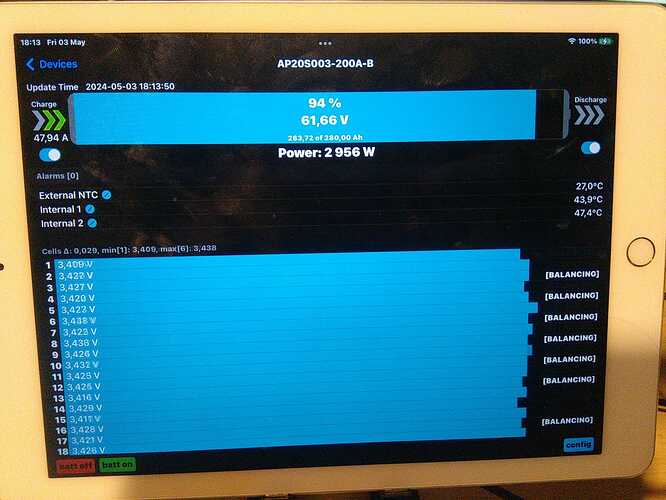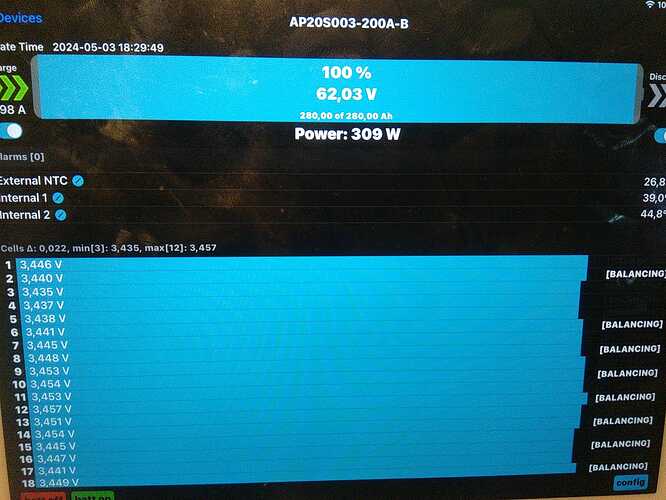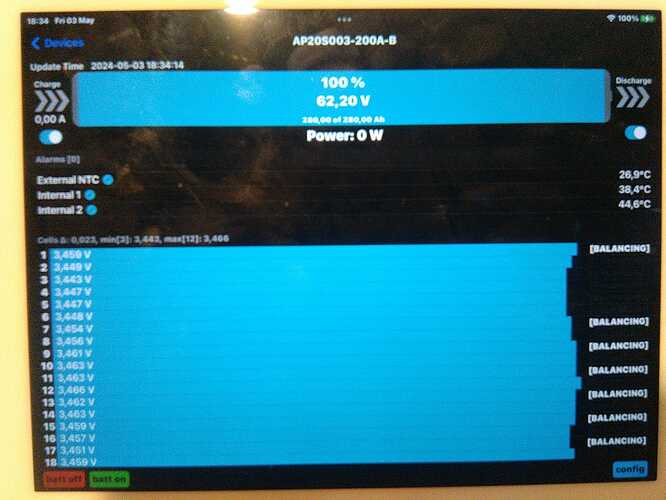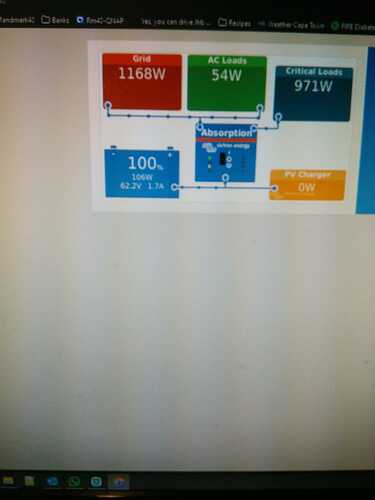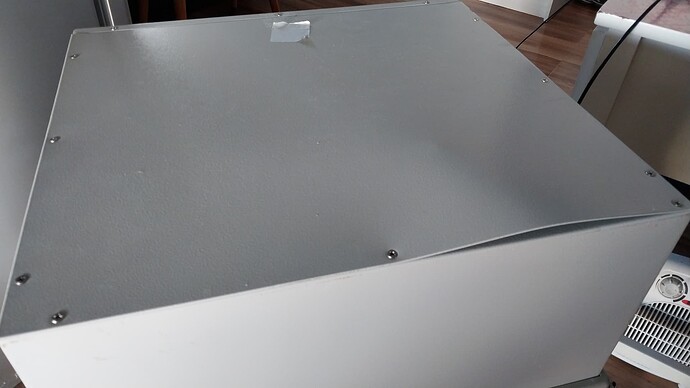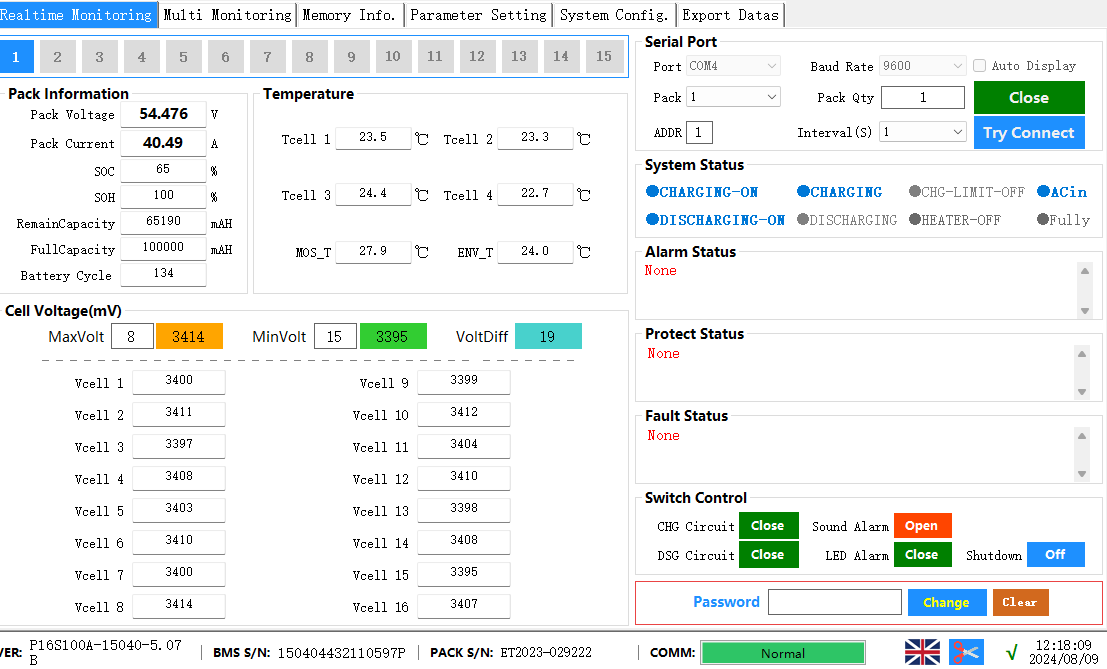How is your DVCC set up? Use can set max charge current there to 10 Amps or whatever you feel like and it will limit the charge current to whatever you set it to
Thanks, no limits set.
Yes I was thinking to do it here. From what SOC should I do this you think? Where does the most balancing occur?
Above 90%, 95%, is where the drama starts.
Above 98% is where the cells “run away”.
So see what works for your bank.
Obviously, if the batt is integrated with the system, there is already throttling happening. You just drop it even lower.
I tend to use Eskom for balancing, like when the weather is/was bad, and at night.
More controlled/consistent than using panel daytime.
You need to cycle with voltage set to 55v then onve they come into balance let the BMS take charge ver
If I can demonstrate what happens inside them boxes, kinda, give or take a few caveats between manufacturers and whatnot.
Note: This is 100% Victron in control, there is no connection between the BMS and the Cerbo.
Slowing down the watts to the batt: (Was at like 3.8kW)
Some slowing down some more:
Getting there: (BMS SOC is 100% cause I told it to be 100% at 3.45v)
It is done:
Now the question: Why is it still balancing?
Because of THIS:
According to the Smarshunt, there is still a 106w going into the batt.
The BMS does not see that.
Now you know. Write it down. ![]()
Ps. Once the cells are fully charged, and balanced, Victron will draw the volts down to the float volt setting, 3.375v if memory serves. Every time. Won’t keep it at 3.45v, yet the SOC stays at 100%.
A quick update. Batteries are still the same. Freedom won organized a site visit last week but cancelled last minute. They then called me and asked if I would be willing to open the batteries and charge the cells individualy with a specialized charger they would send me. I said yes, no problem, as long as verything is recorded and logged as soon as the warranty seals are breaked. They still claim that unbalanced cells (only at full charge) is causing the SOC% differences between the batteries. The 2 new ones have a Delta voltage of mostly 120mV now and the old battery 50mV. ESS have been set on optimized (with batterylife) for about three weeks now and because my PV is sized for 10kWh batteries and not 15 like installed now, they haven’t discharged less than 45% in a while, reaching 100% SOC everyday.
I’m just living with it now. They now about the problem so if anything goes South with any of the batteries I’m standing back seeing that I’ve done everything they’ve instructed me to do and more.
August 2024 this issue will be going for a year now.
I would have asked them to do it themselves… Risk is on you if anything goes wrong. Very strange for a supplier to ask this from a user ![]()
Edit: Aren’t the batteries all still under warranty…?
I think they’ve got an issue with the distance. They were adament to do a 2 day site visit but canceled last minute and then asked if I would be willing to open up and charge the cells individually with a charger they would send me. I agreed with terms that need to be met to cover myself and the warranty on the batteries.
I still don’t trust their judgement saying that the cell imbalance is directly related to the SOC% differences between the old and new batteries. I’ve also discovered recently that under heavy loads, the Amps drawn (according to the PACE BMS’s) from the batteries differ with almost 10Amps. In the spesific instance my hot water geyser was on and at the time batteries #1 & #2 (the new ones) discharged at 37A each while the older one only at 27A. This would explain why the older battery always has a higher SOC% than the other ones but the engineer insists that it’s impossible for the BMS to throttle discharge from one battery only and that discharge should be equal on all connected batteries. I don’t know but the longer they take to resolve the issue the longer I get to use the loan battery.
Seen it, lived it.
Have not seen a BMS yet that can 'throttle" discharge. Inverter, yes, not the BMS.
Would have opened that banks, with permission in writing, and checked the cells visually.
If all looks fine, would have then …
There is some kind of problem there. I have a minor problem with my 10/8. Battery reports SOC correctly to the inverter, but the LEDs on the outside of the battery don’t report SOC correctly in some cases. They have agreed that it should be fixed under warranty. We have agreed that they will come to me and do the fix on site and I will pay a call out fee for this.
Then nothing. Repeated phone calls get a “we’ll call you back” and now we’re stuck in a seemingly endless loop of me calling to remind them and them saying that somebody will call me back.
Same here. Every now and then I send them some screenshots of PMBStools and now and then they call me with some kind of arrangement only to cancel it again later on. As I said, I actually got my new battery and told them I will not send back the loan battery until the issue have been fully resolved. The thing is now that the loan battery belongs to Herholdt’s so if nd when they want they’re battery back, they’ll need to resolve this with FW first. I bought the batteries from them even though I accept that they did not manucture it, they are the reseller,
I have been reading this thread with interest
How are your three batteries connected to the inverter? Do you use a busbar?
I think you were getting to the crux of the matter when you realised that one battery had less discharge rate compared to the other two?
How are they connected? Cable sizes?
Sooo. A long due update. So FW sent me a charger preset to 3.5V to manually charge and top balance the cells of the 2 newer batteries which had a delta V of up to 160mV at 100% SOC. According to the FW technicians and engineers, This was the cause why the 2 new batteries an the old one had such a big difference in SOC% (still up to 40% difference at lower charge levels). I still called BS on their theory but still did what they advised and charged the lower cells on the 2 newer batteries. I did this on 3 occasions but still the Delta V did not drop below 80mV.
The batteries was stacked with the old one at the bottom, new battery in the middle and the loan unit on top. (I had different configurations in the past which did not make any difference to the SOC% problem) The reason for the old one being at the bottom was to be able to access the one’s that needed to be charged more easily.
The last time I changed the stack configuration was about 6 weeks ago. Saturday, however, I decided to remove the whole bank to sommer vacuum and clean underneath it. The batteries and inverters are installed in my bedroom where the DB is so are kept clean but living in the Karoo, dust do settle in placed you cannot reach with a broom or vacuum cleaner.
When I took the 2nd pedestal off the bottom (old) battery I found that the case was dented. Well at first it looked dented from the outside but I then realised it was dented from the inside? very strange indeed! I removed the top cover and shockingly found that the cells are swollen so much that they bent the compression bracket and case. Now i’ve been checking these batteries ate least 3 times a week with PBMS tools and never have there been any sign or errors of overcharging, overtemperature, unbalanced cells…nothing at all to point in any direction that it’s becoming a ticking timebomb. No as I said, the last time I had this battery open (meaning without batteries stacked on top and a pedestal covering the swollen cases) was around 6 weeks ago. There was no visible damage to the case then so the swelling must’ve happenend since then.
I immediately disconnected the battery an took it outside and packed it in the box the new one came in. I’ve now got a R28k paperweight standing on my porch, waiting for FW to read their emails.
But the best part yet…the two newer batteries, both with latest firmware (which the old one could not get) are now perfectly balanced. Both SOC% are within 1% range and Delta Voltage of 4mV.
From the beginning of this problem I told FW that I suspect that this is a firmware issue and that the old and new batteries are not compatible (unlike they clearly state in their manual and brochure that you can ad new batteries to old ones within 5 years or 1500 cycles)
Now that the old battery has been taken out of the equation, the issue with the newer ones sorted itself out.
I never tested the bank without the old battery because this was how the bank would be installed in future, one old eTower and one new eTower (which FW sent me after my other old eTower died).
I think I proved my point now being that the issues lied with old and new version Pace BMS’s that were not compatible seeing that they could not be updated to the same version Firmware.
Now the ball is in their court and I’m sitting with a timebomb on my porch. I checked this morning, The BMS has since switched off on the swollen battery so I cannot connect my laptop to do diagnostics.
I see the previous poster asked about cabling. The three batteries was connected by the busbars provided by FW. From there the cables provided by FW (I think 35m2) runs to a Smartshunt on the - side and a busbar on the + side. Equal length cables of about 900mm between the batteries and busbar/smartshunt.
From the busbar there’s 2 cables, same size, equal lenghts going to each of the Multiplus 48/3000 inverters, wirth a battery disconnect with 160A fuses. cable length from busbar/shunt to inverters is about 600mm. The MPPT connects to the busbars.
I still saw the difference in discaherge rates on the three batteries throughout the whole diagnosis process. This was the same even with the old battery being moved from the bottom of the stack to the top of the stack, connection cables connected in different configurations (even staggered), adressess on the batteries changed…nothing solved the issue. When batteries were used in standalone mode, they were fine but as soon as the old one and a new one were connected, which way ever, the issues continued, hence my theory that the issue lies with the firmware incompatibility and not the batteries themselve. I’ve have warned FW that wunning the system like this will quite probably cause damage to either the new batteries or the old one but hey, i’m a mechanic, not an engineer, so why should they listen to me who’s been sleeping and monitoring the things from 2m away.
Honestly I’m fedup with FW and espescially the eTowers. I invested in bateries that should’ve lasted at least 8 years but after less than 2 years issues started popping up and after sales service is not non-existant but they seem to have all the time in the world. It takes months to resolve an issue.
I should add that my old battery, the now inflating timebomb, was in perfect condition before they sent me the new batteries to replace my other old one.
What do I do now? I really don’t want this sh@t anymore. Even If they replace the now faulty one as well, I wont even get 50% of my innitial investment cost back when I sell them, if I can even get them sold!!
Can I demand a refund? I don’t have time and money for years of litigation and legal fights but I do know my way around social media quite well…
Any suggestions?
Well, that’s within warranty, right?
Honestly, the whole issue about compatibility on a firmware level… there isn’t too much going on there. Balancing and cell protection happens on a module level. If it fails, it is probably an issue with the quality of the cells (and maybe the BMS, but my money is on cells) of that module.
These batteries often have more than one microcontroller, where the comms isn’t even done by the same controller that handles balancing and other critical issues, and compatibility is way more of a comms thing than anything to do with the chemical make-up of the battery. If they are similar chemistry and same number of cells, and your fuses and switchgear can handle the current of a fault condition in the larger combined battery, it is compatible for all practical purposes.
My opinion is that you are dealing simply with a module that failed within warranty. The concerning part is… it is not the first one… right?
Nope. Everything started with the other battery (bought and installed 2 etowers December 2021) started giving high voltage errors. After they fiddled with settings on both batteries quite a few times remotely, they asked me to send it in and after around three weeks the sent me a new battery. Herholdt’s loaned me a battery (also a 2023 model) in the time mine was at FW and there the issues started and only continued after installed both 2023 eTowers with my 2021 model. A bit worrying I might say.
It’s funny though how the inbalanced cells on both 2023 models almost immediately balanced after I removed the old battery from the bank. I tried manually balancing them 3 times with FW’s charger which did not help. Now, since it’s only been the 2 new ones in the bank, they balanced by themselves overnight.
Weird. All I could think off was that it must be some sort of issue between the BMS’s. I don’t know?
They didn’t. They were always balanced. The discrepancy in SOC, which if I understand it correctly is the issue here, was always caused because one module (the one with the bad cells) was at a different SOC.
When we talk about imbalance, I find that there are multiple concepts that can be confusing.
The first kind of imbalance (and the most important one), is within a series string of cells (or in this case, one module of the battery). To get the full capacity out of that string, you want all of them to be above 3.45V at the same time (one of them will always jump out a bit more).
The second kind is where you have two modules in parallel, but they are at a different SOC. This is where equal DC cable lengths and all that comes in. This kind of imbalance usually manifests as a reported SOC that gets stuck somewhere below 100% (because the upper layers of the BMS tends to average things). This imbalance can be fixed in a single good charge: Once one module is full, the other one will absorb all the remaining charge.
I could be wrong on this – in fact recently I was in a bit of a debate with the boss over how balancing works and it turns out I was mistaken in at least one way – but I don’t think parallel modules has an effect on series balancing of adjacent modules. If it does… that is a major defect in the BMS implementation. Every module should take care of its own balancing. The communication between master/slave modules so as to present a single unified “battery” to the inverter… that is mostly just summarising the individual values (average of the SOC, sum of the currents, etc). Balancing decisions are not made on this level.
So, maybe I am wrong, but to me it still seems more likely that you just had a bad module all along, which threw off all the other observations.
This is quite possible. Saturday was the first time I opened this module though, only after visible damage could be noticed from the outside of the casing. Never have the old battery shown any errors (864cycles) and according to PBMStools it’s cells were best balanced between the 3 units with full charge delta voltage of around 6mV and at any discharged state below that running at around 3mV. That’s why we never did any further tests on the old one. FW did fiddle with settings a lot in their remote sessions but all seemed well with the unit untill I, moslty by luck, saw the disformed casing and inspection it further from there. The compression bracket has got a sharp edge veeeery close to cell #16 and I would expect it to break the isolation and penetrating the cell if further swelling will commend, thus I decided to get it out of my house.
I mention again that the times I tested the batteries as standalone units, all performed well and capacity tests were well within spec but in a bank, connected together, gremlins showed up in form of SOC% discrepancies en cells showing out of balance. I never tested the voltage on seperate cells with an external tester and trusted the BMS readings so would’nt know if they really were out of balance (top balanced anyway, discharged they were all good) but the fight I have with FW is:
1* The “warrant” the cells for 6000 cycles at 80%dod;
2* The firs two batteries were bought and commisioned together but the first one that failed showed 360 cycles while the one that failed now showed 731 cycles at the time. why??
3* The old battery’s firmware is upgradeble to v1.10 and the newer ones to v5.07, a clear indication that they’re now using a upgraded version of the Pace BMS.
4* They could’nt confirm with 100% certainty that the 2 firmwares are 100% cross compatible,
5* After gremlins start showing up with the newer model loan battery, would I have the same issues with the new replacement battery?
6* Gremlins continued with the new replacement battery, my old battery AND the loan battery. The new ones work perfectly together but as soon as I add the old one to the pack problems showed up.
7* Now the main issue I hammering on. Since they’ve replaced a faulty battery with a newer one, I’m having issues directly decreasing my battery capacity. Would’nt I then have the same issues should I decide to add more betteries to increase my capacity? yet in their brochures and manuals they guarantee a seamless integration of newer and older batteries within 5 years/1500cycles.
This is where I’m getting at! I budgeted and bought a 10kWh bank of batteries of which I knew I could effectively use 8kWh, planning to double that after 2-3 years.
Before I could even get more batteries, one of the originals failed giving me months of headaches to get it replaced under warranty and even after it was replaced under warranty, the replacement battery caused some unexplainable issues with the old one, decreasing my capacity by almost 3kWh (yes with all three ((old, new and loan)) batteries I only had around 9kWh/189Ah use before reaching a bank SOC of 20%). Testing each one individually showed a capacity of between 89 and 91Ah before switching off at 7%SOC.
Long story short. 2 failed batteries within 3 years, 360 cycles on the first and 850 on the second. New and old batteries clearly do not play together nicely even though they insist that it should.
I’ve called 3 times already today. Someone will phone back but yet no one does. Emails are unanswered. I cannot send the unit to FW without a ticket number and yet the ticket number of the first RMA is still open because the issue wasn’t resolved.
If I knew I would have such k@k with LiFePo4 batteries I would’ve kept my lead acid bank, which I knew I would have k@k with.
One try to invest in something that is install and forget, yet your investment now sits in a box on the porch because you’re scared it might ignite. No man!! Emotions are running high here.
Hectic set of issues… I must also say I don’t think LiFePo4 is the issue. I have had no (touch wood) issues but I have Pylontech 5000’s.
Lets hope FO gets back to you soon. This will hurt their reputation one way or the other…
Lekker guys. So the battery was sent to FW tech department. After about two weeks they contacted me now and said that they the cells passed capacity and load tests and that they are charging the battery to get it ready for collection.
I asked Lufuno if they replaced the swollen cells upon which he replied “The battrey is still fine its just some of the cells were swollen and the capacity for the cells are still good. I didnt replaced the cells i just fix the casing.” (note that he spelled “battrey” the same in 3 seperate emails)
Apparently they want me to put the battery, with the swollen cells, back in use. WTF? I don’t feel safe to put them back in my home and if I’m going to consider it I’m demanding written consent from Freedom Won with them accepting responsibility for any future damages resulting from that battery failing or combusting.
What do you guys think? I think I’m sick and tired of their bullshit now!!!

